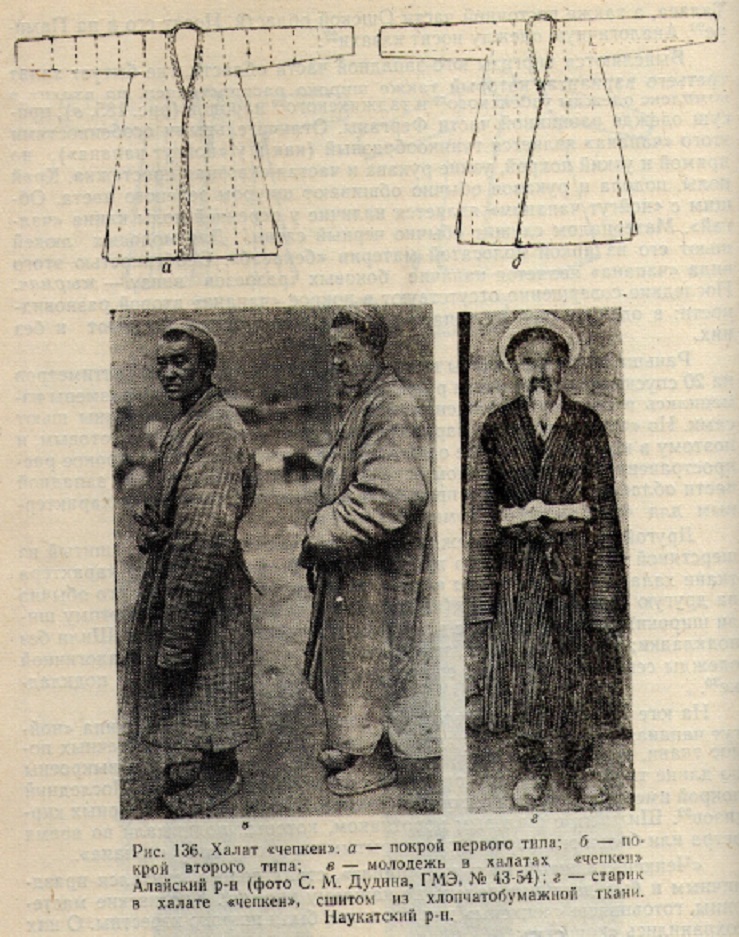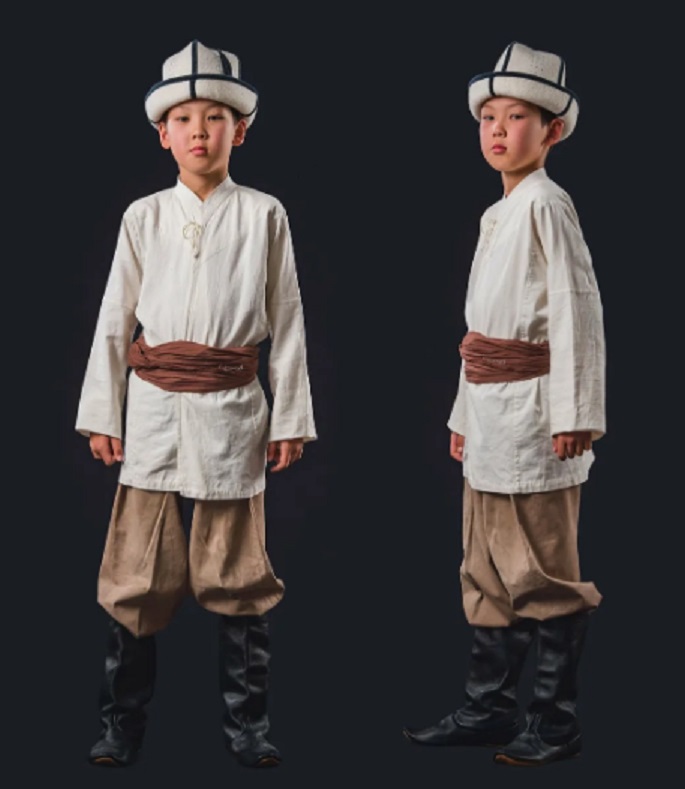
The men's outerwear known as a robe is characterized by great diversity. In the past, it was considered improper to leave the house without it. During cold weather, men wore robes such as chapans, chepkens (chekmen), tons (postuns), and ichiks. Nowadays, "chapan" and "ton" continue to be worn. All of them are fastened on the right side, which is typical for the clothing of ancient Turkic nomads.
The outerwear called "chapan" is made with cotton (or wool) and is always quilted. The lining is usually made of calico (previously - mata). There are three local variants of this clothing among the southern Kyrgyz, reflecting different paths of the ethnic history of their wearers.
The oldest type of clothing among the Kyrgyz is the one known as noigut chapan or tuura chapan (Fig. 135, a). It is made from black, often dark blue, dense fabric, has a tunic-like wide cut, with sleeves sewn at a right angle to the shoulder and tapering towards the wrist, and a diamond-shaped gusset. At the bottom, the clothing flares out due to side wedges. A wedge called chalgay, which has frequent stitching, is also sewn to the front. The collar, like all types of this clothing, has a stand at the back and gradually narrows at the front.
The clothing is quilted with stitches spaced 3-4 cm apart. This type of "chapan" has been recorded among the Kyrgyz belonging to the noigut tribal group (Batken region). This form is also found among the nearby Kipchak group.
Robes of the same cut were also made for boys. This is evidenced by a robe acquired by S. M. Dudyn in the Alai Valley.
The second variant of quilted outerwear is the kaptaja chapan or urumcha chapan (Fig. 135, b). It is usually made from black smooth or striped fabric. In the late 19th century, it became fashionable to make this clothing from colored Russian calico in dark tones. The cut of this "chapan" is loose, with wide flaps that allow for a deep wrap. At the bottom, the robe also flares out due to side wedges. Characteristic of the "kaptama chapan" are the sewn shoulders and sleeves with a rounded armhole. This cut of the robe differs from the typical tunic-like cut found in Central Asia. In addition, this robe differs from others in that it is not quilted through and only the lining is secured with cotton. These noted features are likely related to changes in Kyrgyz costume after the incorporation of Northern Kyrgyzstan into Russia.
The distribution area of such chapan is very wide. It is typical outerwear for the Kyrgyz of Tian Shan, Issyk-Kul, Talas, as well as the eastern part of the Osh region. It is also worn in Pamir. Similar clothing is worn by Kazakhs.

The Kyrgyz of the southwestern part of the region stand out, where a third variant of the robe is prevalent, which is also widely distributed but is part of the clothing complex of the Uzbek and Tajik peoples (Fig. 135, c), characteristic of the clothing of the lowland part of Fergana. Distinctive features of this "chapan" include a tunic-like (like the "noigut chapan") but straight and narrow cut, narrow sleeves, and frequent through stitching. The edges of the flaps, hem, and sleeves are usually trimmed with green cord. Common with the "noigut chapan" is the presence of a wedge "chalgay" at the front flap. The material is usually black satin. For young people, it is made from bright striped fabric "bekasab." A feature of this type of "chapan" is the presence of side slits at the bottom — zhyrmach. The latter are completely absent in the cut of the "chapan" of the second variety; in the clothing of "noigut chapai," slits are allowed, but they can also be made without them.
Previously, quilted robes were made very long, with sleeves dropping about 20 cm below the wrist. Over the past half-century, the sizes have changed towards reduction. Kyrgyz women sew "chapans" themselves. However, the "chapai" of the third variant is more often purchased ready-made at the market, and therefore it is becoming increasingly widespread in the southern clothing complex. While in the last century it was worn only by the Kyrgyz of the western part of the region, now it is penetrating eastward, becoming characteristic of the "Fergana" clothing complex.
Another type of outerwear is chepken (chekmen) — a robe made from woolen fabric produced at home. Depending on the type of fabric, the robe is called basma chepken or piyaz chepken. It was usually worn over other outerwear (over "chapai" and even over a fur coat), so it was made wide, long, with long and wide sleeves. It was made without a lining; this distinguishes the southern Kyrgyz "chepken" from similar clothing of northern Kyrgyz, which is mostly made with a lining.
In southern Kyrgyzstan, two cuts of this clothing are noted: 1) of the type "noigut chapan" (Fig. 135, a), where the sleeves are sewn from transverse strips of fabric, and 2) "chepken" without a wedge at the front flap, with sleeves cut according to the length of the fabric and with a slightly rounded armhole (Fig. 135, b).
The latter cut resembles the cut of the "chepken" that was common among northern Kyrgyz. They were made with a shawl collar, which could be raised during windy or very cold weather, and with an open collar, like that of the "chapan."
The "chepken" made from "piyaz" fabric was expensive, considered festive, and was not accessible to every Kyrgyz. Kyrgyz craftswomen who prepared "chepkens" for sale were widely known. There are "koshokis" preserved about them:
My chepken made by a master
Is decorated with white mother-of-pearl.
It passes freely through the ring,
Sent to the market of Andijan,
And at distant foreign markets, it is in demand
Purchased by the mingbashi.

The "basma chepken" was more accessible to the people. It was especially popular among shepherds and hunters, who wore it during bad weather, using it as a cloak.
Currently, "chepkens" are not made; old ones are still worn. However, cotton fabrics are still used to make them for the elderly, preserving the original cut (Fig. 136).
Men's trousers of the Kyrgyz













































